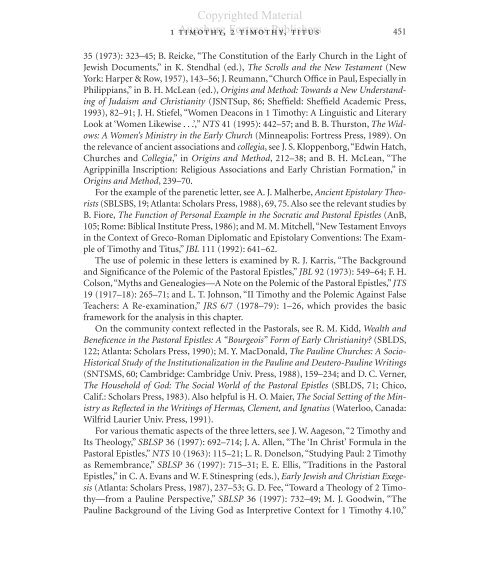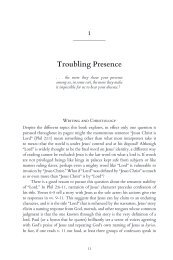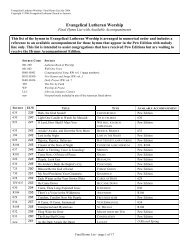19. Pastoral Letters: 1 Timothy, 2 Timothy, Titus - Augsburg Fortress
19. Pastoral Letters: 1 Timothy, 2 Timothy, Titus - Augsburg Fortress
19. Pastoral Letters: 1 Timothy, 2 Timothy, Titus - Augsburg Fortress
You also want an ePaper? Increase the reach of your titles
YUMPU automatically turns print PDFs into web optimized ePapers that Google loves.
Copyrighted Material<br />
1 <strong>Augsburg</strong> timothy, <strong>Fortress</strong> 2 timothy, Publishers titus 451<br />
35 (1973): 323–45; B. Reicke, “The Constitution of the Early Church in the Light of<br />
Jewish Documents,” in K. Stendhal (ed.), The Scrolls and the New Testament (New<br />
York: Harper & Row, 1957), 143–56; J. Reumann,“Church Office in Paul, Especially in<br />
Philippians,” in B. H. McLean (ed.), Origins and Method: Towards a New Understanding<br />
of Judaism and Christianity (JSNTSup, 86; Sheffield: Sheffield Academic Press,<br />
1993), 82–91; J. H. Stiefel, “Women Deacons in 1 <strong>Timothy</strong>: A Linguistic and Literary<br />
Look at ‘Women Likewise . . .’,” NTS 41 (1995): 442–57; and B. B. Thurston, The Widows:<br />
A Women’s Ministry in the Early Church (Minneapolis: <strong>Fortress</strong> Press, 1989). On<br />
the relevance of ancient associations and collegia, see J. S. Kloppenborg,“Edwin Hatch,<br />
Churches and Collegia,” in Origins and Method, 212–38; and B. H. McLean, “The<br />
Agrippinilla Inscription: Religious Associations and Early Christian Formation,” in<br />
Origins and Method, 239–70.<br />
For the example of the parenetic letter, see A. J. Malherbe, Ancient Epistolary Theorists<br />
(SBLSBS, 19; Atlanta: Scholars Press, 1988), 69, 75. Also see the relevant studies by<br />
B. Fiore, The Function of Personal Example in the Socratic and <strong>Pastoral</strong> Epistles (AnB,<br />
105; Rome: Biblical Institute Press, 1986); and M. M. Mitchell,“New Testament Envoys<br />
in the Context of Greco-Roman Diplomatic and Epistolary Conventions: The Example<br />
of <strong>Timothy</strong> and <strong>Titus</strong>,” JBL 111 (1992): 641–62.<br />
The use of polemic in these letters is examined by R. J. Karris, “The Background<br />
and Significance of the Polemic of the <strong>Pastoral</strong> Epistles,” JBL 92 (1973): 549–64; F. H.<br />
Colson,“Myths and Genealogies—A Note on the Polemic of the <strong>Pastoral</strong> Epistles,” JTS<br />
19 (1917–18): 265–71; and L. T. Johnson, “II <strong>Timothy</strong> and the Polemic Against False<br />
Teachers: A Re-examination,” JRS 6/7 (1978–79): 1–26, which provides the basic<br />
framework for the analysis in this chapter.<br />
On the community context reflected in the <strong>Pastoral</strong>s, see R. M. Kidd, Wealth and<br />
Beneficence in the <strong>Pastoral</strong> Epistles: A “Bourgeois” Form of Early Christianity? (SBLDS,<br />
122; Atlanta: Scholars Press, 1990); M. Y. MacDonald, The Pauline Churches: A Socio-<br />
Historical Study of the Institutionalization in the Pauline and Deutero-Pauline Writings<br />
(SNTSMS, 60; Cambridge: Cambridge Univ. Press, 1988), 159–234; and D. C. Verner,<br />
The Household of God: The Social World of the <strong>Pastoral</strong> Epistles (SBLDS, 71; Chico,<br />
Calif.: Scholars Press, 1983). Also helpful is H. O. Maier, The Social Setting of the Ministry<br />
as Reflected in the Writings of Hermas, Clement, and Ignatius (Waterloo, Canada:<br />
Wilfrid Laurier Univ. Press, 1991).<br />
For various thematic aspects of the three letters, see J. W. Aageson, “2 <strong>Timothy</strong> and<br />
Its Theology,” SBLSP 36 (1997): 692–714; J. A. Allen, “The ‘In Christ’ Formula in the<br />
<strong>Pastoral</strong> Epistles,” NTS 10 (1963): 115–21; L. R. Donelson, “Studying Paul: 2 <strong>Timothy</strong><br />
as Remembrance,” SBLSP 36 (1997): 715–31; E. E. Ellis, “Traditions in the <strong>Pastoral</strong><br />
Epistles,” in C. A. Evans and W. F. Stinespring (eds.), Early Jewish and Christian Exegesis<br />
(Atlanta: Scholars Press, 1987), 237–53; G. D. Fee, “Toward a Theology of 2 <strong>Timothy</strong>—from<br />
a Pauline Perspective,” SBLSP 36 (1997): 732–49; M. J. Goodwin, “The<br />
Pauline Background of the Living God as Interpretive Context for 1 <strong>Timothy</strong> 4.10,”




